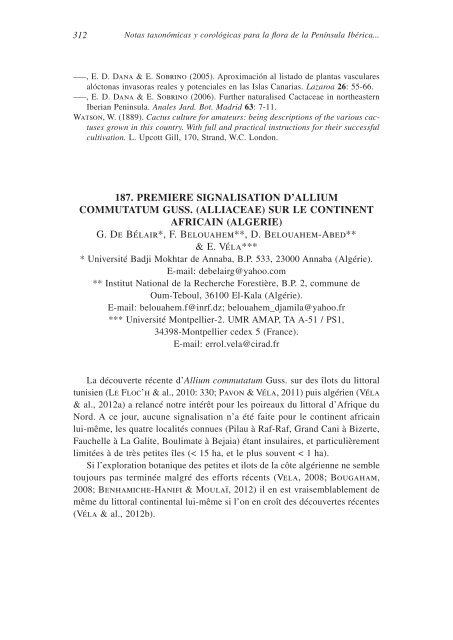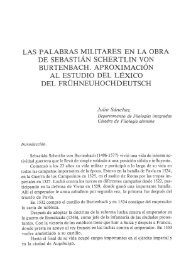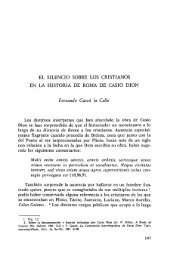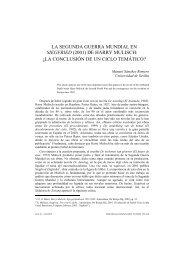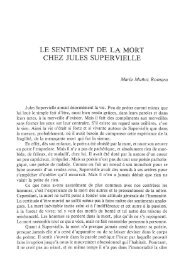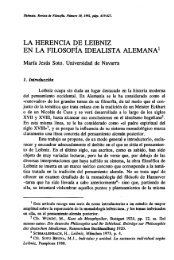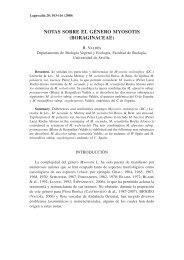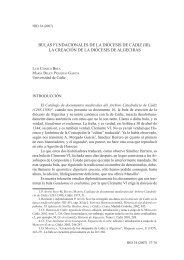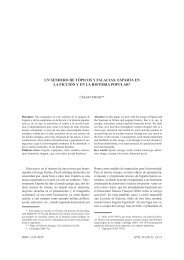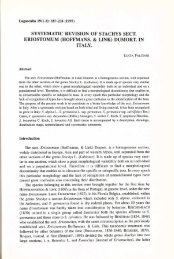notas taxonómicas y corológicas para la flora de la península ...
notas taxonómicas y corológicas para la flora de la península ...
notas taxonómicas y corológicas para la flora de la península ...
You also want an ePaper? Increase the reach of your titles
YUMPU automatically turns print PDFs into web optimized ePapers that Google loves.
312<br />
Notas <strong>taxonómicas</strong> y <strong>corológicas</strong> <strong>para</strong> <strong>la</strong> <strong>flora</strong> <strong>de</strong> <strong>la</strong> Penínsu<strong>la</strong> Ibérica...<br />
–––, E. D. Dana & E. Sobrino (2005). Aproximación al listado <strong>de</strong> p<strong>la</strong>ntas vascu<strong>la</strong>res<br />
alóctonas invasoras reales y potenciales en <strong>la</strong>s Is<strong>la</strong>s Canarias. Lazaroa 26: 55-66.<br />
–––, E. D. Dana & E. Sobrino (2006). Further naturalised Cactaceae in northeastern<br />
Iberian Peninsu<strong>la</strong>. Anales Jard. Bot. Madrid 63: 7-11.<br />
Watson, W. (1889). Cactus culture for amateurs: being <strong>de</strong>scriptions of the various cactuses<br />
grown in this country. With full and practical instructions for their successful<br />
cultivation. L. Upcott Gill, 170, Strand, W.C. London.<br />
187. PREMIERE SIGNALISATION D’ALLIUM<br />
COMMUTATUM GUSS. (ALLIACEAE) SUR LE CONTINENT<br />
AFRICAIN (ALGERIE)<br />
G. De Bé<strong>la</strong>ir*, F. Belouahem**, D. Belouahem-Abed**<br />
& E. Vé<strong>la</strong>***<br />
* Université Badji Mokhtar <strong>de</strong> Annaba, B.P. 533, 23000 Annaba (Algérie).<br />
E-mail: <strong>de</strong>be<strong>la</strong>irg@yahoo.com<br />
** Institut National <strong>de</strong> <strong>la</strong> Recherche Forestière, B.P. 2, commune <strong>de</strong><br />
Oum-Teboul, 36100 El-Ka<strong>la</strong> (Algérie).<br />
E-mail: belouahem.f@inrf.dz; belouahem_djami<strong>la</strong>@yahoo.fr<br />
*** Université Montpellier-2. UMR AMAP, TA A-51 / PS1,<br />
34398-Montpellier ce<strong>de</strong>x 5 (France).<br />
E-mail: errol.ve<strong>la</strong>@cirad.fr<br />
La découverte récente d’Allium commutatum Guss. sur <strong>de</strong>s îlots du littoral<br />
tunisien (Le Floc’h & al., 2010: 330; Pavon & Vé<strong>la</strong>, 2011) puis algérien (Vé<strong>la</strong><br />
& al., 2012a) a re<strong>la</strong>ncé notre intérêt pour les poireaux du littoral d’Afrique du<br />
Nord. A ce jour, aucune signalisation n’a été faite pour le continent africain<br />
lui-même, les quatre localités connues (Pi<strong>la</strong>u à Raf-Raf, Grand Cani à Bizerte,<br />
Fauchelle à La Galite, Boulimate à Bejaia) étant insu<strong>la</strong>ires, et particulièrement<br />
limitées à <strong>de</strong> très petites îles (< 15 ha, et le plus souvent < 1 ha).<br />
Si l’exploration botanique <strong>de</strong>s petites et ilots <strong>de</strong> <strong>la</strong> côte algérienne ne semble<br />
toujours pas terminée malgré <strong>de</strong>s efforts récents (Ve<strong>la</strong>, 2008; Bougaham,<br />
2008; Benhamiche-Hanifi & Mou<strong>la</strong>ï, 2012) il en est vraisemb<strong>la</strong>blement <strong>de</strong><br />
même du littoral continental lui-même si l’on en croît <strong>de</strong>s découvertes récentes<br />
(Vé<strong>la</strong> & al., 2012b).


